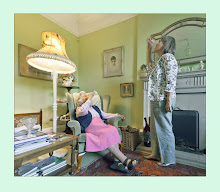I had gone to see Martin Parr's exhibition of photographs made in the Bristol area for a second time partly to meet up with other OCA students, an unofficial study day, yet also to listen to a social historian talk about the photographs on display. However, the talk was by Phil Walker who had worked closely with Martin Parr over the exhibition since the social historian was unable to attend.
Martin Parr is liked by some and disliked by others; I am a liker but want to understand the other view. Perhaps it is just a matter of taste but there are those who do seem to raise a serious objection to Parr. He is an internationally renowned photographer, a documentarist who is head of Magnum UK and whose work is also considered art. One can look at his work in different ways such as the social historic which is really the basis of this exhibition. Parr came to Bristol in the late 1980's, producing The Cost of Living (1987), when there was the divided society of the late Thatcher era.
For Parr, the role of photography is to exaggerate and some of his images contain not so much a punctum, what Barthes describes as an area of significant detail, but are themselves a punctum, a punctured view of the world. Photography tends to be used to make things look better than they actually are and Parr challenges this.
Does Parr reveal any truths about Bristol or is Bristol just a backdrop for his view of the world. Henri Cartier-Bresson, one of the founding members of Magnum, suggested that Parr might be from another planet. His work is seen by some as dispassionate and detached.
One image of two people standing outside their prefab house does have historical significance. There are not many of such buildings left and there is talk of the remaining ones being listed. Parr met with the occupiers who are photographed standing outside.
A photograph of a Yoga class taking place in the city is indicative of the kind of alternative culture that exists in Bristol. The photograph of Airbus workers at work is also a reminded of the kind of industry found in Bristol.
One photograph of four women in Cribbs Causeway standing facing the photographer in what amounts to a portrait photograph. This attracted a lot of criticism as not being representative of the shopping centre as a whole yet as usual, Parr had interacted with his subjects and what makes this photograph special is that the four women are all from the same family, ranging from Great Grandmother to Great Grandchild. The photograph hence gives us an insight into Cribbs Causeway through contact with it's people rather than merely representing part of the building.
Parr takes thousands of pictures every year yet is usually only happy with about 10 of them!! For him, photography is a calling as well as a profession. Editing is not easy owing to there being so many images to consider.For this exhibition, Parr managed to edit down his images to 600 from which the 60 on display were chosen.
There are recognisable themes to Parr's work such as consumerism, shopping, issues around class etc Parr claims he is trying to be objective in his search for truth. Photography is a "soap opera"! There is subtle stage management as he knows what he is looking for.
Another striking image is of a rather dubious looking yacht salesman, a sign of the times when greed was considered good.
The Commonwealth Society Function where a young black man faces a couple of older Britons has an obvious narrative of racial tension.
There is a garden open day which features what appear to be a couple with a child; there is no proof of this particularly since they do not seem to be communicating with each other although they do both wear Rohan trousers of similar material. Perhaps their apparent dysfunctionality is a result of the presence of the photographer. As with much of Parr's work, there is a constructed narrative at work along with a dry humour and an unflattering approach.
Mshed are going to purchase 10 works from this exhibition that are about the city and representative of Parr's work; visitors have the chance to vote for the one they like.
Anti-consumerism images include an attractive jar of lemon curd from a church fete with the winner's name written on a label.
A photograph called The Clifton Club (2008) shows a rack of towels in cubby holes; they look almost like pieces of ivory and are reminiscent of one of Fox Talbot's earliest photographs of china pieces in a chest.
One aspect of these photographs is that one is not aware of the photographer making the pictures, they speak for themselves.
There is a view of Parr's work that it is perhaps cruel and lacking in empathy; it is not a people's art.
Parr's images contain mini-dramas.
One OCA student reckons he could have done photographs as good as those Parr has made; what makes Parr's work as art!?
Editing can be painful ... how to select from so many images. Some images are meaningless, not striking in any way.
Parr's people are not posed and possibly not representative of Bristol.

No comments:
Post a Comment